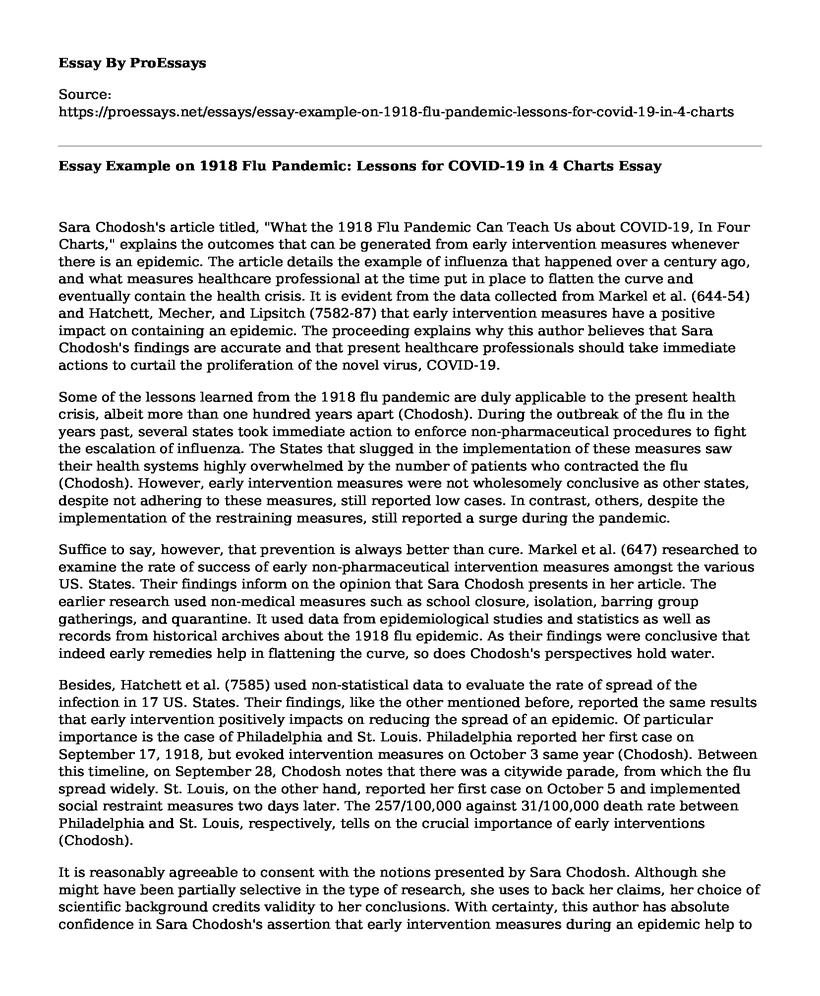Sara Chodosh's article titled, "What the 1918 Flu Pandemic Can Teach Us about COVID-19, In Four Charts," explains the outcomes that can be generated from early intervention measures whenever there is an epidemic. The article details the example of influenza that happened over a century ago, and what measures healthcare professional at the time put in place to flatten the curve and eventually contain the health crisis. It is evident from the data collected from Markel et al. (644-54) and Hatchett, Mecher, and Lipsitch (7582-87) that early intervention measures have a positive impact on containing an epidemic. The proceeding explains why this author believes that Sara Chodosh's findings are accurate and that present healthcare professionals should take immediate actions to curtail the proliferation of the novel virus, COVID-19.
Some of the lessons learned from the 1918 flu pandemic are duly applicable to the present health crisis, albeit more than one hundred years apart (Chodosh). During the outbreak of the flu in the years past, several states took immediate action to enforce non-pharmaceutical procedures to fight the escalation of influenza. The States that slugged in the implementation of these measures saw their health systems highly overwhelmed by the number of patients who contracted the flu (Chodosh). However, early intervention measures were not wholesomely conclusive as other states, despite not adhering to these measures, still reported low cases. In contrast, others, despite the implementation of the restraining measures, still reported a surge during the pandemic.
Suffice to say, however, that prevention is always better than cure. Markel et al. (647) researched to examine the rate of success of early non-pharmaceutical intervention measures amongst the various US. States. Their findings inform on the opinion that Sara Chodosh presents in her article. The earlier research used non-medical measures such as school closure, isolation, barring group gatherings, and quarantine. It used data from epidemiological studies and statistics as well as records from historical archives about the 1918 flu epidemic. As their findings were conclusive that indeed early remedies help in flattening the curve, so does Chodosh's perspectives hold water.
Besides, Hatchett et al. (7585) used non-statistical data to evaluate the rate of spread of the infection in 17 US. States. Their findings, like the other mentioned before, reported the same results that early intervention positively impacts on reducing the spread of an epidemic. Of particular importance is the case of Philadelphia and St. Louis. Philadelphia reported her first case on September 17, 1918, but evoked intervention measures on October 3 same year (Chodosh). Between this timeline, on September 28, Chodosh notes that there was a citywide parade, from which the flu spread widely. St. Louis, on the other hand, reported her first case on October 5 and implemented social restraint measures two days later. The 257/100,000 against 31/100,000 death rate between Philadelphia and St. Louis, respectively, tells on the crucial importance of early interventions (Chodosh).
It is reasonably agreeable to consent with the notions presented by Sara Chodosh. Although she might have been partially selective in the type of research, she uses to back her claims, her choice of scientific background credits validity to her conclusions. With certainty, this author has absolute confidence in Sara Chodosh's assertion that early intervention measures during an epidemic help to limit the gravity of the spread (Chodosh). More so, Chodosh presents graphical data to emphasize on her claims. Such data add merit to the article's relevance and validity, especially at this present time, when the world is faced with yet another epidemic as the one witnessed over a century ago.
Works Cited
Chodosh, Sara. "What The 1918 Flu Pandemic Can Teach Us About COVID-19, In Four Charts". Popular Science, 2007, https://www.popsci.com/story/health/coronavirus-1918-flu-pandemic/. Accessed 19 Apr 2020.
Hatchett, Richard J., Carter E. Mecher, and Marc Lipsitch. "Public health interventions and epidemic intensity during the 1918 influenza pandemic." Proceedings of the National Academy of Sciences vol. 104, no. 18, pp. 7582-7587, 2007, https://doi.org/10.1073/pnas.0610941104. Accessed 19 April 2020.
Markel, Howard, et al. "Nonpharmaceutical Interventions Implemented by US Cities during the 1918-1919 Influenza Pandemic." Jama vol. 298, no. 6, pp. 644-654, 2007), doi:10.1001/jama.298.6.644. Accessed 19 April 2020.
Cite this page
Essay Example on 1918 Flu Pandemic: Lessons for COVID-19 in 4 Charts. (2023, May 23). Retrieved from https://proessays.net/essays/essay-example-on-1918-flu-pandemic-lessons-for-covid-19-in-4-charts
If you are the original author of this essay and no longer wish to have it published on the ProEssays website, please click below to request its removal:
- Sickle Cell Disease Essay
- American College of Sports Medicine Paper Example
- Pill Poppers: Film Analysis Essay
- A Reflective Essay on Indigenous Health
- History of Public Health Nursing Paper Example
- Community Service Work Experience Paper Example
- Paper Sample on Hospital Management: Strategies for Success







